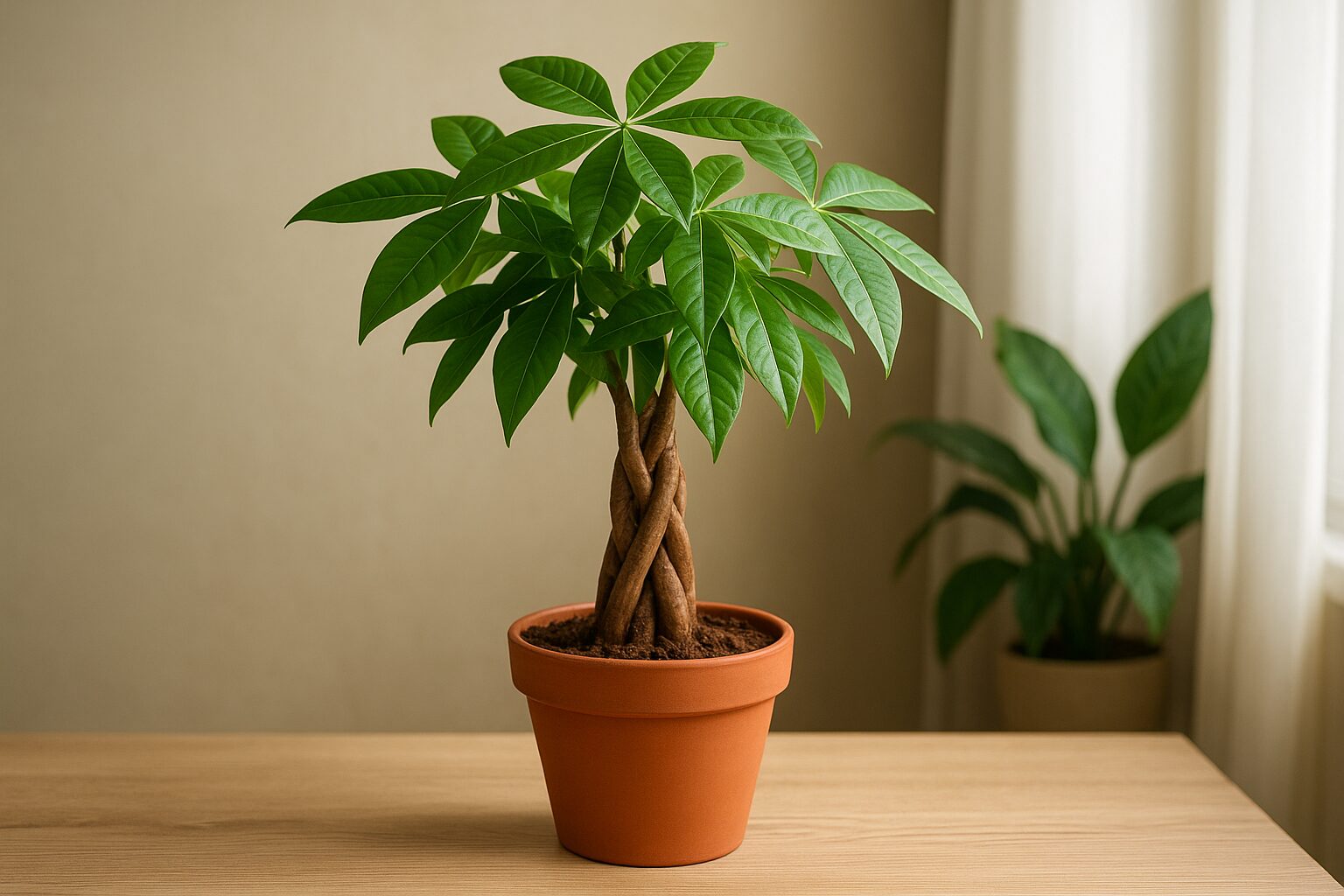The money tree, scientifically known as Pachira aquatica, is a tropical plant native to Central and South America. Its distinctive braided trunk and shiny green leaves make it a favorite in homes and offices. Beyond its beauty, many people choose a money tree for its Feng Shui benefits, believing it attracts wealth, good fortune, and positive energy.
This guide is designed to provide practical tips on choosing, caring for, and maintaining a healthy money tree, ensuring it remains vibrant and continues to bring joy and luck to your indoor spaces.
What is a Money Tree?
Botanical Background and Origin
The money tree originates from wetlands in Central and South America, where it can grow up to 60 feet in the wild. In indoor settings, it’s usually kept smaller, typically 2–6 feet tall, making it perfect for apartments and offices.
Symbolism and Meaning
In Feng Shui, the money tree is believed to bring wealth, abundance, and positive energy to its owner. The five leaves on each stem represent the five elements of Feng Shui: wood, water, fire, earth, and metal. Cultures in Asia, especially Japan and China, often gift money trees as a symbol of good luck and prosperity.
Physical Characteristics
- Leaves: Shiny, green, palmate leaves with 5–7 leaflets.
- Trunk: Often braided for aesthetic appeal.
- Size: Indoor money trees usually grow 2–6 feet tall; outdoors, they can reach 60 feet.
- Flowers: Rare indoors, but when they bloom, the flowers are creamy white with red accents.
Choosing the Right Money Tree
Selecting a healthy plant is crucial to long-term success. Here’s what to look for:
Selecting a Healthy Plant
- Vibrant green leaves without spots or discoloration.
- Firm, well-shaped trunks (braided or single).
- Free of pests or disease.
Considerations
- Size: Choose a plant that fits your indoor space.
- Leaf Color: Deep green leaves are a sign of health.
- Braided Trunks: Braiding does not affect health but adds aesthetic value.
Choosing the Right Pot and Soil
- Use a pot with drainage holes to prevent root rot.
- Soil: Well-draining potting mix with peat moss or perlite ensures healthy growth.
Pro Tip: Avoid heavy clay pots that retain water, which can harm roots.
Ideal Growing Conditions
Money trees thrive under specific conditions. Meeting these needs ensures healthy growth and longevity.
Light Requirements
- Bright, indirect sunlight is ideal.
- Avoid direct sun, which can burn leaves.
- Low-light areas may slow growth but won’t necessarily kill the plant.
Temperature
- Keep indoor temperatures between 65–75°F (18–24°C).
- Protect from drafts or sudden temperature changes.
Humidity
- Money trees love moderate to high humidity.
- Mist leaves occasionally or use a humidity tray during dry seasons.
Soil
- Well-draining, nutrient-rich soil is crucial.
- A mix of peat moss, perlite, and sand works best.
Watering Your Money Tree
Watering correctly is essential for a healthy money tree. Overwatering or underwatering are the most common issues.
How Often to Water
- Water every 1–2 weeks, allowing soil to dry slightly between waterings.
- Adjust frequency depending on indoor humidity and season.
Signs of Overwatering
- Yellowing leaves
- Drooping leaves
- Root rot
Signs of Underwatering
- Brown leaf tips
- Curling leaves
- Dry, brittle soil
Best Practices
- Always check soil moisture with your finger.
- Ensure proper drainage to prevent standing water.
Visual Tip: Include a small soil moisture chart for reference:
| Soil Moisture | Action |
|---|---|
| Dry 1–2 inches | Water plant |
| Slightly moist | Wait 2–3 days |
| Wet | Do not water |
Fertilizing Your Money Tree
Fertilization encourages growth and maintains lush, green leaves.
Recommended Fertilizer
- Use liquid houseplant fertilizer or slow-release granules.
- Balanced fertilizer (10-10-10 or 20-20-20) is ideal.
Feeding Schedule
- During spring and summer, feed every 2–4 weeks.
- Reduce fertilization in fall and winter, when growth slows.
Pruning and Maintenance
Pruning keeps your money tree healthy and encourages fuller growth.
Trimming Leaves and Branches
- Remove yellowing or dead leaves.
- Trim branches to shape the plant or control size.
Encouraging Growth
- Prune lightly in spring to promote new shoots.
- Avoid over-pruning, which stresses the plant.
Common Problems and How to Fix Them
Even well-cared-for money trees can face challenges. Here’s how to handle common issues:
Pests
- Spider mites and aphids are common indoors.
- Wipe leaves with soapy water or use insecticidal spray.
Diseases
- Root rot: Caused by overwatering; repot with fresh soil.
- Leaf spots: Fungal issues; remove affected leaves and adjust watering.
Other Issues
- Drooping leaves: Usually underwatering or low light.
- Stunted growth: May need repotting or more light.
Graph Idea: Include a small visual guide showing pest signs and leaf symptoms.
Repotting Your Money Tree
Repotting is essential as your money tree grows.
Signs It’s Time to Repot
- Roots growing out of drainage holes
- Water draining too quickly
- Plant top-heavy or outgrowing the pot
Step-by-Step Repotting Guide
- Choose a pot 1–2 inches larger than the current one.
- Remove plant gently, shaking off old soil.
- Trim any damaged roots.
- Place in fresh potting mix and water lightly.
- Keep in indirect light for a week to recover.
Best Pot Sizes and Soil
- Pot: Slightly larger than root ball
- Soil: Well-draining mixture with perlite or sand
Money Tree Feng Shui Tips
Money trees are not just beautiful—they’re symbols of good fortune.
Placement for Positive Energy
- Place in southeast corner for wealth, east for family energy.
- Avoid bathrooms, kitchens, or cluttered spaces.
Combining with Other Plants
- Pair with lucky bamboo or jade plants to enhance Feng Shui.
Symbolic Practices
- Rotate the tree occasionally for even energy flow.
- Occasionally dust leaves to maintain positive energy and vitality.
Frequently Asked Questions (FAQs)
1. How fast do money trees grow?
Indoor money trees grow 6–12 inches per year, depending on light, water, and fertilization.
2. Can money trees survive in low light?
Yes, but growth may slow, and leaves may become pale. Bright, indirect light is optimal.
3. How to propagate a money tree?
Propagate through stem cuttings or air layering. Cut a healthy branch, let it dry for a day, and plant in moist soil.
4. How often should I rotate my money tree?
Rotate every 2–3 weeks to ensure even growth and light exposure.
5. Are money trees safe for pets?
Yes, money trees are generally non-toxic to cats and dogs, but monitor for excessive chewing.
6. How do I prevent pests on my money tree?
Common pests include spider mites and aphids. Wipe leaves with soapy water or use insecticidal spray regularly to keep your plant healthy.
7. Is my money tree toxic to pets?
No, money trees are generally non-toxic to cats and dogs, though it’s best to prevent excessive chewing of leaves.
8. When should I repot my money tree?
Repot when roots grow out of drainage holes, soil dries too quickly, or the plant becomes top-heavy. Usually every 2–3 years.
9. Where should I place my money tree for good Feng Shui?
For wealth and abundance, place it in the southeast corner of your home or office. For family energy, the east corner is ideal. Avoid bathrooms and cluttered areas.
Conclusion
A money tree is more than just an indoor plant—it’s a symbol of luck, prosperity, and positivity. By following the steps outlined above, you can ensure your money tree thrives, bringing beauty and positive energy into your home or office.
Start by choosing a healthy plant, place it in the right spot, and maintain it with proper watering, light, and fertilization. With a little care and attention, your money tree will reward you with lush green leaves and a welcoming aura of luck.
Disclaimer
This article is for informational purposes only. Individual plant care may vary depending on your local climate, indoor conditions, and plant variety. Always consult with a professional horticulturist if you experience persistent plant health issues.



